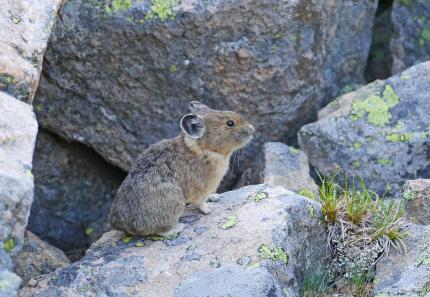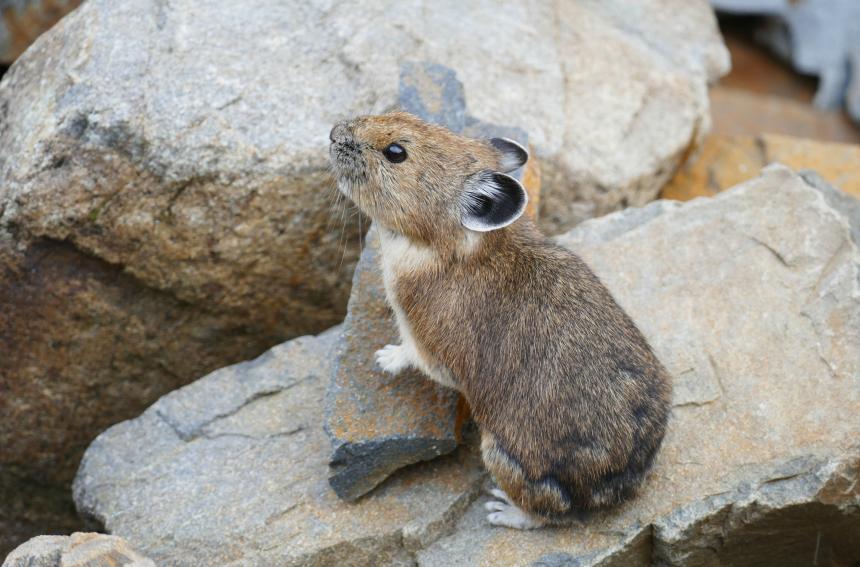High
The population size of American pika in Washington is unknown. It is a montane talus habitat specialist that may face threats from climate change.
If you see this species, please share your observation using our Pika Observation Survey App:
The instructions below must all be done on your smartphone.
- On your smartphone, download the ArcGIS Survey 123 app, available for both iOS and android.
- Open the ArcGIS Survey 123 app and allow permissions for location, photos, recordings, camera use, etc.
- Click 'continue without signing in'
- On your smartphone, return to this page and click this link. A 'Pika Observation' form should load.
- Enter your pika data! Photos are particularly helpful.
- To record another observation, return to the ArcGIS Survey 123 app and select 'Pika Observation' form.
The below video shows you how to report your pika sighting, step by step:
Description and Range
Physical description
American pika have small, round bodies that range in length from 6 to 8 inches, and no visible tail. The fur color ranges from shades of gray to tannish-brown. It has large, round ears, and is a relative of rabbits and hares.
Ecology and life history
American pika habitat is restricted to rocky talus slopes, primarily the talus-meadow interface. They are often found above tree lines up to the limit of vegetation, though they can also survive in rocky areas within forests or near lakes. Pikas do not dig burrows, but they may enlarge dens or nest sites under rock. They are sensitive to temperatures above 78 degrees Fahrenheit and rely on winter snowpack to insulate them from extreme cold conditions.

Pikas are generalist herbivores that cache food in summer for winter consumption. Food sources typically include grasses, “forbs” (non-woody flowering plants), leaves, ferns, moss, and conifer needles, depending on availability.
Pikas reproduce in summer and may have two litters, averaging one to three young per litter. However, usually only young born in the first litter survive to weaning. In most areas, births begin in May and peak in June, but young may be born as early as March in some low elevation areas. Young are dependent on their mother for at least 18 days, and are weaned as early as three to four weeks. Juveniles establish territories and hay piles in the summer of birth, but do not breed until their second summer. The maximum lifespan for the American pika is seven years.
Geographic range
American pikas are found throughout the Cascade Mountains and at higher elevations of the northeast regions of Washington where suitable talus fields in close proximity to food resources are found. Although they are considered a high elevation species, pika populations have been found at low elevations near sea level in the Columbia River Gorge, and at selected locations in Snohomish and Skagit counties as low as 1150 feet. Population sizes and trends in Washington are unknown.
For a map of range-wide distribution and conservation status of this species, check out NatureServe Explorer.
Climate vulnerability
Sensitivity to climate change
High
The American pika displays high sensitivity because of its preferred habitat type and condition, low reproductive rate, and limited dispersal ability. The pika requires a moderate amount of snowpack to provide insulation during the winter months; decreasing snowpack because of rising temperatures and shifting precipitation patterns with more rain than snow will negatively impact this species. Pikas have high energetic demands, partly because they do not hibernate; increasing temperatures and extreme heat events may affect the species’ ability to forage during the day. In addition, climate change will likely alter the composition of vegetation in montane habitats; this shift may be to plant species less suited to the pika's nutritional needs. Populations forced to higher elevations in mountainous regions will become increasingly isolated.
Exposure to climate change
Moderate-
High
- Increased temperatures
- Reduced snowpack
- Shifts from snow to rain
Conservation
Conservation Threats and Actions Needed
- Fish and wildlife habitat loss and degradation
- Threat: Disturbance to microclimate on talus slopes. Increase in rock climbing and bouldering at select American pika sites in Columbia River Gorge.
- Action Needed: Work with partners to better understand distribution of occupied sites; evaluate recreation intensity and access.
- Climate change and severe weather
- Threat: Climate change may be affecting species distribution and population trends.
- Action Needed: Work with partners to better understand distribution of occupied sites; monitor to assess impacts of warming environment.
See the Climate vulnerability section for more information about the threats posed by climate change to this species.
Hike and Help Pikas
If you plan on hiking this summer, consider helping us collect data about pikas! Your observations could help biologists better monitor pika populations, which is critical for understanding how to protect these critters. Read our "Hike and help pikas" blog to learn more.
Resources
References
Bruggeman, J. E. 2011. Factors affecting pika populations in the North Cascades National Park Service Complex. Final Report, to North Cascades National Park Service, 110pp.
Smith, A. T. and M. L. Weston. 1990. Ochotona princeps. Mammalian Species 352:1-8.
Varner, J. and M. D. Dearing. 2014. Dietary plasticity in pikas as a strategy for atypical resource landscapes. Journal of Mammalogy 95:72-81.
